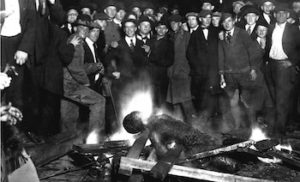
*The Omaha race riot occurred on this date in 1919. This was a race riot episode in Omaha, Nebraska. It resulted in the lynching of Will Brown, a Black citizen, and the death of two white rioters.
Three weeks before the riot, federal investigators had noted that "a clash was imminent owing to ill-feeling between white and black workers in the stockyards." The number of Blacks in Omaha doubled during the decade 1910–1920 as they were recruited to work in the meatpacking industry. In 1910, Omaha had the third largest black population among the new western cities, which had become a destination following Reconstruction and during the Great Migration that started in the 1910s. By 1920, the Black population more than doubled to over 10,000, second only to Los Angeles, which had nearly 16,000. It was ahead of San Francisco, Oakland, Topeka, and Denver.
The major meatpacking plants hired Blacks as strikebreakers in 1917. South Omaha's working-class whites showed great hostility toward black strikebreakers. By this time, the Irish ethnic group, the largest and earliest group of immigrants, had established their power base in the city. Several years earlier, following the death of an Irish policeman, ethnic Irish had led a mob in an attack on Greektown, driving the Greek community from Omaha. Following several strikes throughout the previous year, two detectives with Omaha Police Department's "morals squad" shot and killed a Black bellhop on September 11.
Sensationalized local media reports of the alleged rape of 19-year-old Agnes Loebeck on September 25, 1919, triggered the violence associated with Will Brown's lynching. The following day, police arrested 41-year-old Will Brown as a suspect. Loebeck identified Brown as her rapist; however, during questioning, Brown stated that Loebeck did not make an identification, which Loebeck later refuted. There was an unsuccessful attempt to lynch Brown on the day of his arrest. It followed more than 20 race riots in major industrial cities of the United States during the Red Summer of 1919. The Omaha Riot was denounced throughout the country.
The arrest and prosecution of mob leaders were widely demanded. Police and military authorities apprehended 100 of the participants on charges ranging from murder to arson and held them for trial. The Army presence in Omaha was the largest in response to any of the race riots, with 70 officers and 1,222 enlisted men. By early October, the emergency had passed, and the Army contingent declined to two regiments by mid-month. The district court ordered a grand jury to convene and investigate the riots, and a grand jury was impaneled on October 8.
After a six-week session, the grand jury issued a report that criticized the Smith administration for ineffective leadership and police incompetence. Army witnesses believed that more prompt police action could have controlled the riot. One hundred and twenty indictments were handed down for involvement in the riots. Of the 120 persons indicted for involvement in the riot, most were never successfully prosecuted, and all were eventually released after serving no term of imprisonment.